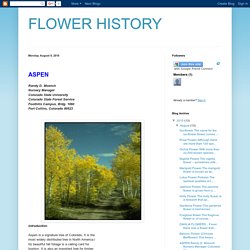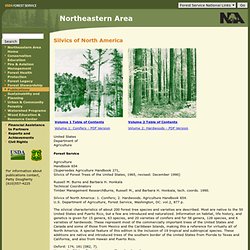

FLOWER HISTORY. Randy D.

MoenchNursery ManagerColorado State UniversityColorado State Forest ServiceFoothills Campus, Bldg. 1060Fort Collins, Colorado 80523 Introduction Aspen is a signature tree of Colorado. It is the most widely distributed tree in North America.i Its beautiful fall foliage is a calling card for tourism. It is also an important tree for timber.
Flower and Sex Identification Aspen is typically dioecious. Figure 1: Greatly enlarged aspen pistil or capsule from female flower. Color can be deceptive and helpful both. Figure 2: Newly emerged female aspen flower. Is obvious as the bright red structure in this photo. Silvics Manuals-Volume 1 and Volume 2, USFS. United States Department of Agriculture Forest Service Agriculture Handbook 654 (Supersedes Agriculture Handbook 271, Silvics of Forest Trees of the United States, 1965, revised: December 1990) Russell M.

Burns and Barbara H. Honkala Technical Coordinators Timber Management ResearchBurns, Russell M., and Barbara H. Honkala, tech. coords. 1990. Silvics of North America: 1. The silvical characteristics of about 200 forest tree species and varieties are described. Oxford: 174, 181 (082, 7). Cover art: Natural stands of southern pine and cypress bordering a lake in Noxubee County, MS Foreword "Silvics of Forest Trees of the United States," Agriculture Handbook 271, was the first comprehensive document of its kind in the United States.
Our store of silvical and related knowledge has markedly increased since that silvics manual was published 25 years ago. Jerry A. This publication also reports research involving pesticides. Acknowledgments. T&T Seeds Ltd. ASPB 2010 Poster supplementary material. Damián Cirelli and Janusz Zwiazek Welcome, this is the supplementary material for the poster "Three allies for virtualizing plant physiology labs", presented at ASPB's 2010 Plant Biology meeting in Montréal.

Since the only resource we had in the Montréal meeting was paper (nothing wrong with that, just a fact), we thought we could put a demo of part of the lab on-line for your inspection. We want to share what we think is a great lab activity or a primer to a real physical lab using live plants and a photosynthesis meter. None of these ideas are a breakthrough in education or in computer science, and to be honest the technologies used are several years old.
What we want is to get the point across that with the infrastructure provided by the internet as a delivery medium and a web browser as an interactive content renderer, these simple-to-use technologies are overlooked and could yield much more that what is presented here as a working proof of concept. In short, here you can: Contact: Stomata, Subsidiary Cells, and Implications. [ Home ] [ Articles ] Foreword Past research by this worker concentrated on the members of the tropical genus Stanhopea, with only scattered samples from terrestrial orchids.

For this line of research, it was fruitful to develop and employ a method of obtaining a casting of the leaf surface for certain epiphytes, but for terrestrial orchids in particular, there is really no substitute for working with live fresh leaf material. Specimens undergo deformation when dried, and although morphological studies may be productive to a certain extent when they are reconstituted, critical cell measurements remain compromised. The leaf casting system developed by this worker for his doctoral research is limited when studying decidedly pubescent to rugose surfaces, ones clad with a heavy waxy cuticle, or for leaves of very light texture as seen in some terrestrial orchid species. Both anatomical and life cycle information need to be provided to field biologists nationally and internationally. EUPHORBIA PBI. Science & Engineering Journal Abbreviations.
Populus L. Populus L. Poplar Hybrids Salicaceae -- Willow family Maurice E. Demeritt, Jr. Poplar hybrids (Populus spp.) are the result of natural and manmade crosses among poplar species. Habitat Native Range Poplar hybrids occur naturally throughout the U.S. and Canada wherever compatible species come into close proximity (table 1). Climate In general, poplar hybrids grow best on humid and microthermal areas with adequate moisture during all seasons of the year. Soils and Topography Poplar hybrids grow best where soils are at least 1 m (3.3 ft) in depth to interrupted bedrock. Associated Forest Cover The two natural hybrids, P. x smithii and P. x jackii, are associated with the parental species in the same stand, and the parental species dominate in the stands. Life History Reproduction and Early Growth. Bamboo Society Of Australia. Columnar Cacti. Plant Physiology Online: Category Listing.